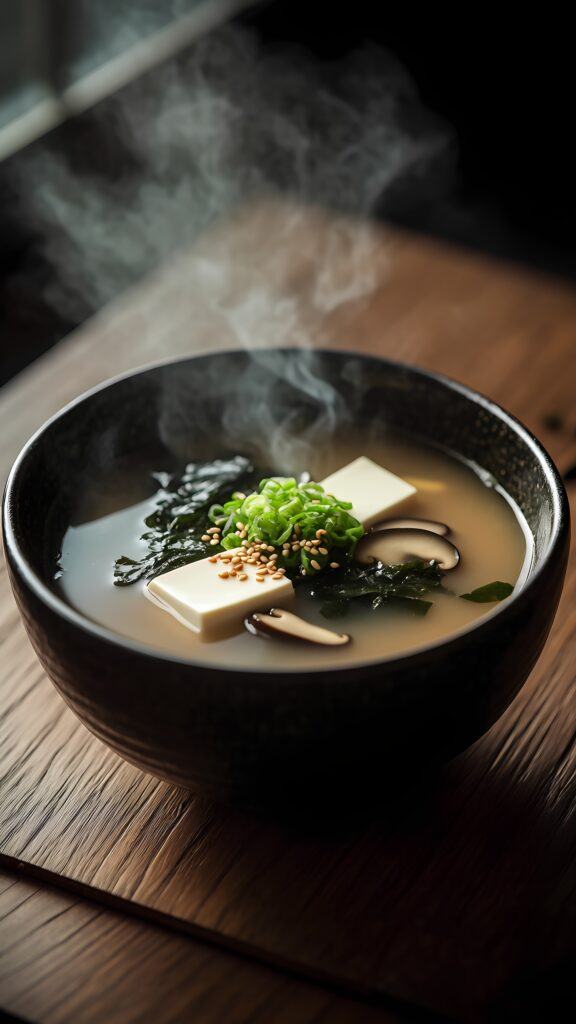Imagine a warm, comforting bowl of miso soup that not only soothes the soul but also nurtures your gut with the wonders of probiotics. This Probiotic Miso Soup is a delightful harmony of flavors and health benefits, inviting you to experience a traditional Japanese culinary practice in a bowl.
Origin and Cultural Significance
Miso soup, a staple in Japanese cuisine, traces its roots back to ancient times. The use of miso paste, a fermented soybean concoction, has been cherished for centuries not only for its umami richness but also for its health-enhancing properties. Traditionally, miso soup serves as a symbol of Japanese home-cooked meals, often enjoyed at breakfast or as a comforting side in a bento box. It embodies a philosophy of balance and wellness, resonating with the Japanese principle of “washoku,” where harmony and nutrition go hand in hand. The addition of probiotics to this age-old recipe elevates it, blending cultural nostalgia with modern health wisdom.
Unique Ingredients and Flavors
What makes this miso soup stand out is its probiotic prowess. By incorporating live, active cultures, we amplify the soup’s natural gut-friendly benefits. The main star, miso paste, is rich in umami—a savory taste that adds depth and complexity. Partnered with dashi, a seaweed and bonito broth, the soup offers a delicate, oceanic essence. Tofu and wakame seaweed join the mix, bringing texture and additional nutrients. The key, however, lies in the gentle simmering process, preserving the probiotics’ vitality. This soup is a testament to the beauty of simplicity, where a handful of humble ingredients transform into a nourishing elixir.
Nourishing Probiotic Miso Soup Recipe for Better Gut
Description
Warm and nourishing, this probiotic miso soup blends traditional flavors with a gut-healthy boost. Perfect for a cozy meal or a refreshing start to any day.
Ingredients
Broth Base
Soup Ingredients
Optional Garnishes
Instructions
Preparing the Ingredients
-
Gather and Prep Your Ingredients
Start by assembling your ingredients: miso paste, tofu, seaweed (like wakame), green onions, and any additional vegetables you'd like to include. Dice the tofu into small cubes, chop the green onions finely, and soak the seaweed in warm water to rehydrate.Consider using a variety of vegetables like shiitake mushrooms or spinach for extra flavor and nutrition. Soaking the seaweed for about 10 minutes will ensure it's tender and ready to use.
Crafting the Broth
-
Simmering the Base
In a medium-sized pot, bring about four cups of water to a gentle simmer. Add a piece of kombu (dried kelp) if you have it for an umami kick, but don't let it boil.Simmer the kombu for about 5 minutes, then remove it before the water reaches a full boil to prevent a bitter taste. -
Miso Magic
Scoop a couple of tablespoons of miso paste into a small bowl. Ladle some of the hot but not boiling kombu-infused water into the bowl. Whisk until the paste is smooth, then gently stir it back into the pot.Avoid boiling the miso to preserve its probiotics and delicate flavors. Taste and adjust the amount of miso to your preference.
Assembling the Soup
-
Adding Tofu and Seaweed
Add the cubed tofu and rehydrated seaweed to the pot. Keep the heat on low and allow them to warm through for about 5 minutes.If you're adding other vegetables, ensure they're cooked to your desired tenderness before serving.
Finishing Touches
-
Garnishing and Serving
Remove the soup from heat. Ladle it into bowls and sprinkle generously with chopped green onions. Serve hot and enjoy the comforting, savory flavors.For an added burst of freshness, a splash of lime juice or a sprinkle of sesame seeds can elevate the taste profile.
Note
- For an added probiotic boost, ensure the miso is added after removing the soup from heat, as high temperatures can kill beneficial bacteria.
- Use unpasteurized miso for maximum probiotic benefits.
- Choose a miso type based on your flavor preference: white miso is mild and sweet, red miso is stronger, and mixed miso offers a balanced taste.
- If you're adding tofu, opt for fermented varieties like fermented soy or chickpea tofu for additional probiotics.
- Consider incorporating fermented vegetables, such as kimchi or sauerkraut, as a garnish to enhance both the flavor and probiotic content.
- To maintain the soup’s probiotic properties, avoid boiling once the miso is added.
- For a gluten-free version, use tamari instead of soy sauce and ensure your miso is gluten-free.
- Seaweed varieties like wakame or kombu add umami and depth while offering their own nutritional benefits, including iodine and trace minerals.
- Store leftovers in the fridge for up to three days. Reheat gently to preserve the probiotic content.
- Pair with a side of fermented pickles or a probiotic-rich salad for a complete meal that’s both nourishing and gut-friendly.















